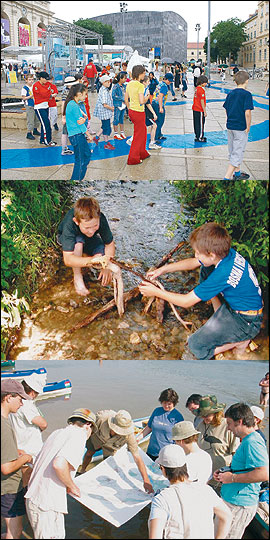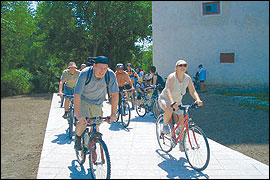 |
Danube Day 2005: Putting people at the heart of the DanubeThe challenge for Danube Day 2005 was to continue the momentum set by last year's celebrations while providing an annual focus for honouring the role of rivers in people's lives and presenting a stimulus for cooperation at all levels. |
 |
Danube Day was full of inspiring
events in each of
the 13 countries. In Austria visitors explored the
twists and turns of an 80 metre model of the
river. In Serbia and Montenegro athletes ventured
out onto the river for a kayak race. A tour in
Hungary focused on the whole river by following
maps with no marked political boundaries. In
Bosnia and Herzegovina, and throughout the basin,
children let their imagination sail for the Danube
Art Masters competition. |
Once again, Danube Day surpassed all expectations with almost 250 activities for the public and professionals. It built on partnerships strengthened in 2004 and prompted people to appreciate and act for their rivers.
Your Danube: more than just water!
Uniting organisations under the slogan, 'The Danube: more than just water',
an overarching theme of Danube Day was the ways in which Danube rivers influence
our lives. Celebrations stressed that rivers are so much more than just
the water they contain - they are arteries of life. Danube Day acknowledged
the geo-political role rivers play as scenes of conflict, but also built
upon their positive unifying force for communities with different cultures
and histories.
The key event was the ICPDR-organised Danube Stakeholder Conference in Budapest,
a major gathering to place the Danube people at the heart of basin decision-making.
The event provided a forum for stakeholder groups and made significant strides
towards participation of external bodies in the ICPDR's work.
Partners help promote awareness.
The Coca-Cola Company's European Union Group and Coca-Cola HBC, who recently
signed a cooperation agreement with ICPDR, helped to support events all
across the Danube Basin, including programmes in Hungary, Slovakia, Serbia
and Montenegro, Romania and Bulgaria. Coca-Cola will also help produce a
joint publication on all of the international and national events to celebrate
Danube Day.
"It is our view that while serving the public through
the creation, production and distribution of products
to the highest international standards, we must also
relate to the broader needs of societies, and show we
believe in having a strong obligation to participation
in community affairs that enhance life, and produce
rewards for everyone," said Sir Michael Llewellyn
Smith, Board Director Coca-Cola HBC.
Bringing the basin to life with colour and sound.
The Danube Environmental Forum (DEF) organised the Danube Photo Competition,
which gave photographers the task of capturing the Danube on film. The 'International
Danube Art Master Competition', also carried out by the DEF together with
ICPDR, united children in an ambitious creative challenge: to visit local
rivers and create artworks reflecting what the Danube means to them. The
collages, sculptures and paintings that resulted lined the banks of rivers
as a visual representation of young people's vision for a positive future.
"I am grateful for such competitions", said Jan Dušek, scientist and school teacher at Uherské Hradište school in the Czech Republic, "because they show us a new dimension to the world: perception through the eyes, mind
and creative hands of young people." Coca-Cola and ICPDR will bring the
winners from each country together in Budapest this autumn for the award
ceremony and selection of the International Danube Art Master.
In a symbolic tribute carried over from the first Danube Day, the Global
Water Partnership's 'Greet the Danube' ship blast was extended this year.
Danube ship workers from Germany to Romania paid tribute to the river and
its value to their livelihoods by sounding their ship's horns in a wave
of sound.
Identifying with the river.
Germany's celebrations brought fun and excitement to the river banks of
Ingolstadt in a family festival. The rivers were the starting point for
the 50th 'TID International Danube Tour', a 2,082km canoe safari from Germany
to Bulgaria, and crowds gathered in the summer heat to cheer the canoeists.
Young visitors were treated to hands-on water experiments, musical programmes
and thrilling motor boat rides. "Children are the protectors of tomorrow's
environment," said Werner-Hans Bhom, German District President.
Danube Day in the Czech Republic reinforced Czech identity with the Danube
Basin and strengthened foreign partner collaboration. An excursion to Czech,
Austrian and Slovak Morava river meadows highlighted the value of areas
at risk from the proposed Danube–Oder–Elbe waterway.
In Vienna's Museums Quartier, 10,000 visitors enjoyed Austria's Danube Day.
Opened by Wolfgang Stalzer of the Ministry of Water Management and Ulli
Sima of the city of Vienna, the celebration included the unveiling of an
80 metre model of the river.
 |
Thousands of blue bracelets were
distributed as reminders that
everyone must work together to save the river. |
Linking hope and promise.
Bratislava was the venue for a host of water activities in Slovakia's tribute
to the Danube. The day opened by Environment Minister László Miklós with
children's musical and artistic activities, street theatre and white-water
rafting at Gabcíkovo. The Global Water Partnership helped organise the 'Danube
Greetings' initiative, which sent children's messages of solidarity to others
in the basin. "We wish the Danube rivers clean water, a variety of plants
and animals, and people who care for our beautiful European rivers," wrote
pupils from Dneperska primary school in Kosice.
In Hungary, conferences were held to discuss conflicts and work together
on common goals. Baja's Second International Conference on the Central Danube
Floodplains involved government and civil society officials from Hungary,
Croatia, and Serbia and Montenegro. In Györ, the North Transdanubian Environment
Protection and Water Directorate led decision-makers and stakeholders from
Györ, Vienna and Bavarian government and partner organisations in a conference
looking at rehabilitation and development projects.
The Ministry of Environment and Water, Coca-Cola and WWF organised an event
with double purposes: to raise awareness on the conservation issue, and
to convince people to save the Danube together. Several thousand bracelets
were distributed to remind people that on this particular day all nations
along the entire Danube basin were joining together to save the river.
 |
International cooperation.
In Croatia, rain didn't prevent a packed day of workshops, field visits,
competitions and songs at Zlatna Greda. Over 60 participants from all government
levels, state enterprises, NGOs and protected areas, and the local populace,
took part in a workshop on protecting the Mura, Drava and Danube, opening
a productive dialogue between stakeholders.
Bosnia and Herzegovina's Danube Day was particularly poignant as this year
has seen the country's signing of the Danube Convention, meaning all 13
countries are now full signatories. One of the main events in Bosnia and
Herzegovina was the conference, 'Aspects of Groundwater Protection in Karst
Landscapes'. Experts from Slovenia, Serbia and Montenegro, Croatia, Austria,
and Bosnia and Herzegovina gathered to share research and experiences of
international cooperation and implementation of the EU Water Framework Directive.
Elsewhere, Slovenia held an international rafting challenge: 'Downhill on
the River Mura'. Entrants with a sense of adventure from Austria, Croatia
and Slovenia managed to stay afloat in all manner of craft as they travelled
down the Mura. Students from a secondary school in Ljubljana created a water
dragon, the symbol of the city of Ljubljana, out of stone from the Sava
River, which was organised in connection with International Sava Day.
Reaching a broad audience.
Serbia and Montenegro's events got everyone talking about Danube rivers
and, with major national media coverage, the message reached millions. Apatin
held an exhibition of works by nature photographer Silard Kovac, and screened
two short films With Danube through Vojvodina by by Nenad Mikalacki and
Regional park Gornje podunavlje by Srdan Ðuranovic. In Grocka, the city
held sports tournaments and the Bolec Art Association held a cultural performance,
and monuments and the museum on the Vinca archaeological site were free
to the public. The closing ceremony of Danube Day in Novi Sad was organised
by the mayor of Novi Sad, and attended by important guests, such as Dragana
Del Monaco and Milica Stojanovic, who performed that night.
Events in Romania engaged a large audience and festivities were held not
only in large towns but also in many villages. The vast array of events
included formal meetings, riverbank festivals, craft fairs, concerts, boat
cruises, fishing contests and public-awareness campaigns. Participants of
the Youth Water Parliament, which gathered in Tulcia in May, designed several
Danube Day activities that took place throughout the basin. "Each of
us can work towards protecting the Danube ecosystem which sustains us,"
said Sulfina Barbu, Romanian Minister of Environment and Water Management.
"Public awareness regarding the protection of the Danube and its tributaries
is essential."
Moldova's Danube Day also looked to the past years of Danube activities,
and to the future EU Water Framework Directive implementation at an event
in Glodeni. Citizens joined representatives from the Ministry of Ecology
and local government to discuss problems such as pollution. Great interest
was expressed in contributing to the integrated river basin management plan.
 |
The IAD-Transboundary Bicycle
Tour Vienna-Bratislava attracted 80 cyclists - many
locals from Austria and Slovakia, but some from as far away as the
USA and Canada. |
Inspiring action in the region.
Support for Danube Day in Bulgaria was tremendous: over 1,500 participants
from kindergartens, schools, business, NGOs and public institutions worked
to get people thinking and talking about the Danube River. The city of Vidin
held an expedition to observe the Danube coastal area and prepare maps and
status reports of the Danube. School children took walks along the river
and prepared their own reports, essays and poems about the river. Discussions
and roundtables in Lom and Svishtov Municipality were dedicated to the reduction
of the pollution of the river and its wealth preservation.
Across Ukraine, people enjoyed river activities and a major Danube exhibition
by the National Union of Artists. Stemming from an idea from the recent
Sixth European Youth Parliament for Water, four Danube Delta youth clubs
from Vilkovo, Kiliya, Izmail and Odessa created a Danube photo album: a
collection of old and recent family photographs, illustrating how the Delta
landscape has changed over the years. In western Ukraine, the 'From Clean
Uh to Clean Danube' events took children on boating adventures to the upper
Uh, where they had the chance to learn more about the river, help with clean-up
operations, and test their skills in environmental games and painting competitions.
Throughout the basin, the energy and enthusiasm that went into making Danube
Day 2005 a success was tremendous. Long may it continue! For more information,
please visit: www.danubeday.org.